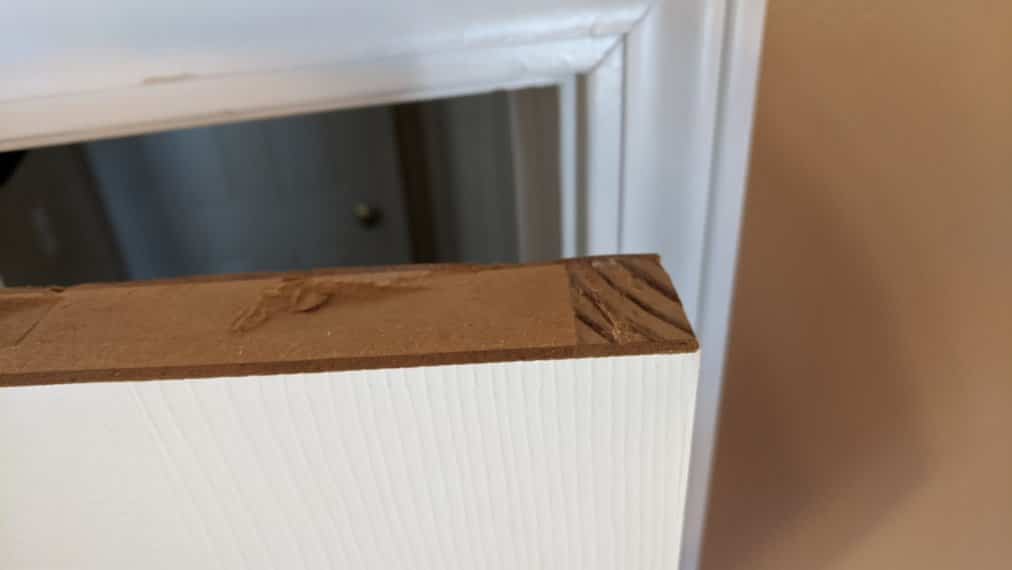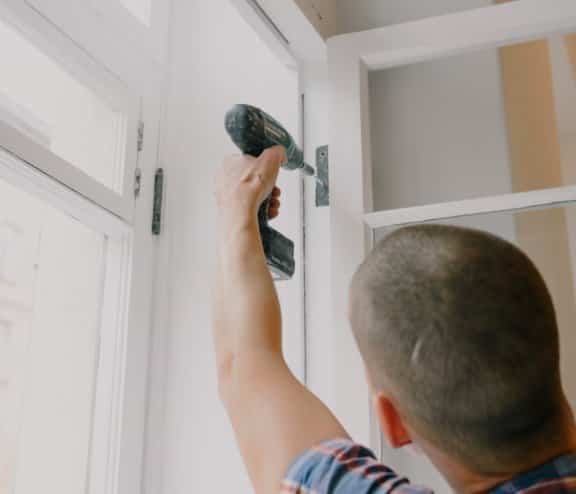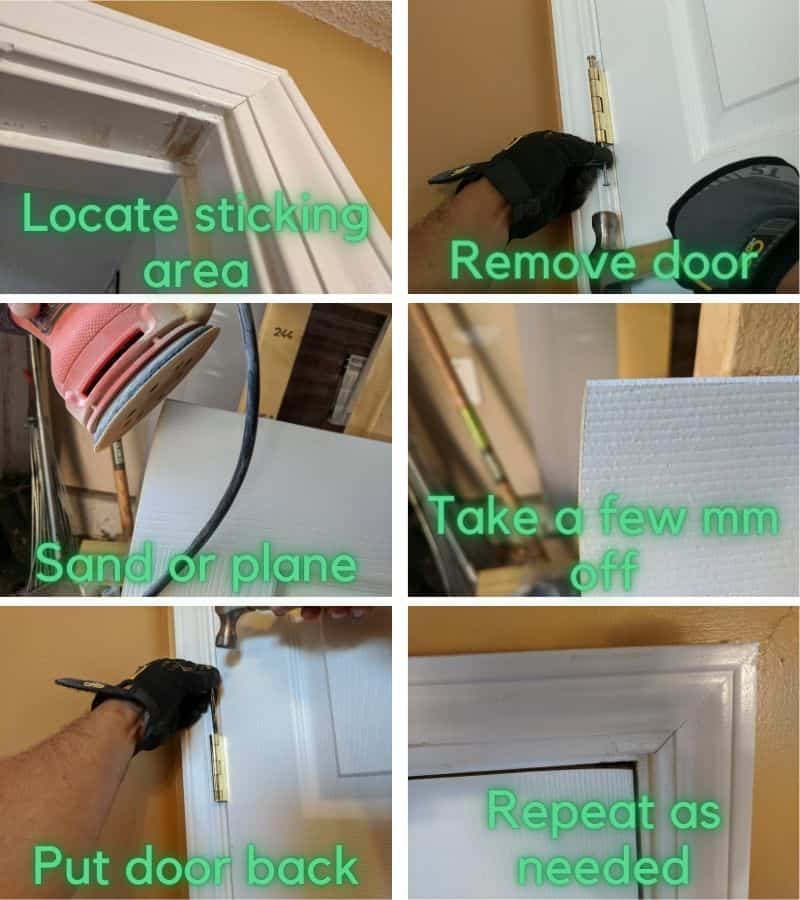How to fix a door sticking at the top of the frame

A few of years ago, our kids’ bedroom door suddenly started rubbing against the top of the frame when closing.
It was a summer season when the door suddenly started sticking to the frame like that.
As any self-respecting dad would do under the circumstances, I ignored the problem, for months. 😎
The problem actually went away on its own after the summer. I was very proud of not wasting my time on something that would go away on its own.
But I had celebrated too soon.
The door started sticking to the frame again in the summer of the following year. And again in the summer this year (2021). 😩
The real problem was the sound that the door stuck to the frame made when (yanked) open. The sound was loud enough to wake the kids up when I left their room after putting them to sleep. 😨
I finally decided to do something about it.
But before I figured out how to stop a door from sticking to the top of the frame, I did a bit of research to find out why my door was suddenly sticking to the to the top of the frame.
This post describes the findings from my research as well as how I fixed the problem.
Hope this post empowers you with some of the information you’re looking for. Enjoy!
Why does my door stick at the top of the frame?
A door may stick at the top of the frame for five main reasons, including loose hinges, door construction relaxing, expansion of wood due to humidity, a settling house foundation that’s causing the frame to fall out of square, and thick paint.
These five reasons are elaborated below.
- Loose hinges: Screws holding the door hinges can become loose over the years, which causes the door to fall out of alignment with the frame. The door will eventually start rubbing against the top right part of the frame.
- Door construction settling: If your door is many years old, the joints in the door construction may have relaxed, causing the construction to relax and stick against the frame (or door jamb).
- Humidity: Expansion of wood due to humidity is the most common reason for a sticky door. Humidity is the only reason for a door to be sticking seasonally in the summer. In the winter, humidity levels are usually lower, because cooler air cannot hold as much moisture. Wood in the door absorbs moisture in the air and expands. The more the humidity, the greater the expansion. Humidity sometimes, especially in the summer, can be high enough to cause an expansion large enough to make the door rub against the frame.
- Foundation settling: Most houses settle a little bit over time as the foundation gradually sinks into the ground. This settling of foundation is completely normal and your house can take it. But the gap between a closed door and its frame is typically in the order of millimeters. Therefore, the foundation settling can lead to the annoying problem of sticky doors because of the door frame falling slightly out of square.
- Thick paint: If you have repainted the door recently with a layers of a thick paint, the door may start sticking to the frame after painting.
The steps outlined in the next section will describe how to fix a sticking door regardless of the root cause of the problem.
How to stop a door from sticking to the top of the frame
You can fix a door sticking to the frame by first tightening any loose screws holding the hinges. If loose hinges wasn’t the issue, mark the part of the door that’s rubbing against the frame, take the door off the hinges by removing the hinge pins, and plane or sand the marked portions of the door. Finally, re-attach the door and repeat the process if needed.
The above steps are elaborated in detail in the following subsections.
Fixing a sticking door by tightening the door hinges
Checking the screws holding the hinges to see if they’re loose, and if they’re loose, tightening them, is the first step to fixing a door rubbing against the frame.
Loose screws typically mean that the door is tilting under gravity and touching the frame.
The solution is to simply tighten the screws using a screwdriver, power drill, or impact driver.

If your house (and so the door) is very old, it’s possible that the screw holes have gotten enlarged and therefore are unable to hold the screws tightly.
In that case, insert a match dipped in wood glue into the screw hole and break it off, as explained in this post. Wait for the glue to dry, and then insert the screw and tighten it.
Alternatively, purchase longer wood screws, e.g., 3 inch screws, and use them in place of the existing screws.
Also, if your house has been repainted multiple times, chances are that the hinges and screws have been painted over. You may need to scrape the paint off to access the screws and screw holes.
Caveat: If you suspect that paint containing lead has been applied to your house in the past, wear protection, and follow guidelines, e.g., the guidelines on this site, to safely scrape off lead paint
Repairing a door that sticks by removing material off the sticking surface
If there are no loose hinges, or if tightening loose hinges does not fix your sticky door, then it’s fair to conclude that the door is sticking due to the door construction settling, humidity, the house foundation settling, or painting.
The best way to fix for these reasons is to remove some material from the part of the door that rubs against the frame (or jamb), until it no longer sticks.
Caveat: Removing material from the door is not reversible! Choose this method of fixing your door only when the other options like tightening the hinges (described in the previous section) and lubricating the sticky area (described in the following section) won’t work.
First, identify the part of the door that’s rubbing against the frame. In most cases, it will be obvious, as the repeated rubbing would have causes that part of the door to lose paint, exposing bare wood.
If it’s not obvious, apply some colored chalk to the frame as demonstrated in this video, close the door, and some of the chalk powder will transfer to the door where the door rubs against the frame.
Once you identify the part of the door that sticks, take the door off the frame.
To take the door off the frame, close the door, and gently tap the hinge pins off the hinges using a hard narrow object and a hammer. I used a common 8″ nail for the narrow object.
Once all the hinge pins are taken off, the door can be gently opened and taken off the frame.
Then, take the door to your workshop, garage, or outdoors, and remove a layer of material (less than 3mm) where the door rubbed against the frame.
You can use a planer or a sander for this material removal. I used an orbital sander with 120-git sandpaper for this step.
Removing material this way will adjust the curvature of the door.
Then, reattach the door.
If the door is still sticking, repeat the above process until it no longer sticks.
The picture below illustrates these steps.
Tip: Once the door has been fixed, you may want to paint door’s edge to match the rest of the door, if you removed material from an edge that’s easily visible. Ideally, you should use the exact paint or stain color you used to paint the door originally. If that is not an option, you can try matching the color as best as possible or consider painting the whole door.

Note: You don’t necessarily need to remove the door to plane or sand it. You may plane or sand it in place, if you’re comfortable with that, you have a helper to hold the door steady, and if you don’t mind the cleanup afterwards. I personally preferred to take the door off before sanding because I wasn’t comfortable with removing material from the door in-place.
Final tips on how to fix a door that rubs against the frame
If your door rubs against the frame only slightly, reducing humidity levels in your house or in the room that the door leads to, or lubricating the part that sticks by rubbing a candle against it may be sufficient to solve the problem.
These tips are elaborated in more detail below.
- Reducing humidity levels: Simply turning on your air conditioning can be enough to remove high levels of humidity. If that doesn’t work, consider using a dehumidifier in the room with the sticking door.
- Lubricate the sticky part: Rub a candle against the edge of the door where it is sticking to lubricate and remove the friction. Candle was is an excellent lubricant and it’s not messy. Alternatives to candle wax here are petroleum jelly and beeswax.